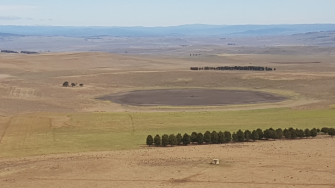
Date: Tuesday, October 24, 2017
Project: Eastern Australian Waterbird Survey
Heading south over the next two days to do the two southerly bands – Band 2 and Band 1. The forecast was a bit worrying with clouds building up in the south. This is an ever present preoccupation for aerial surveys. Before we went to the two most southernmost bands, we finished off Band 3, near Wollongong. Our first wetlands to survey were part of Sydney’s water supply, Cordeaux and Avon Dams, just south of Sydney in the Great Dividing Range.
Surveying Avon Dam, just south of Sydney. These dams have very few waterbirds because of their depth, apart from the odd cormorant.
We then had a great flight down the south coast, on our way down to Wallaga Lake, just north of Merimbula. To match Terry’s northern flight, we saw three pods of humpback whales along the way, calves in tow. They are majestic animals. Near Merimbula, we swept up and down about six estuaries which stretch over the 30 km of the survey band. Nothing unusual to report – just a few swans and cormorants and one young sea eagle. From here we headed west to the Snowy Mountains. But on the way we surveyed the Monaro Plains, just south of Cooma. Unlike previous years, nearly all the wonderful rain-filled lagoons were dry.
Dry rain-filled lagoon on the Monaro Plains, near Cooma. These are wonderful waterbird habitat when wet but today most were dry.
We then headed south to Seaspray to survey the shallow lakes, like Jack Smith Lakes on this part of the coastal Victoria. These wetlands just lie west of 80 Mile Beach. Most of the wetlands were dry, apart from where we surveyed Corner Inlet which had quite a few large migratory wading birds, including godwits and the odd Pacific Gull.
One of the small coastal wetlands, just east of 80 Mile Beach, south of Gippsland Lakes.
Surveying the lakes near Seaspray; the large lakes down here are fantastic for waterbirds when there is water but were mostly all dry.
Surveying the coastal wetlands leading into Corner Inlet in Victoria.
From here, we headed west along Survey Band 1 which lies south of Melbourne and Port Phillip Bay. There were hundreds of swans in Port Phillip Bay and small numbers of straw-necked and Australian white ibis were breeding on a swamp just north of Rhyll on Phillip Island. Phillip Island had some great wetlands with lots of waterbirds, including large numbers of Cape Barren Geese. It was becoming increasingly obvious that there were many more waterbirds down on this survey band, where the water was, than further to the north. Every little dam had waterbirds and the big dams even had hundreds of grey teal, hardhead and coot.
Surveying over Phillip Island, over the Grand Prix race track to find the small lagoons with flocks of grey teal, Australian shelduck, swans and Cape Barren Geese.
We soon finished the lagoons on Phillip Island and headed over the Otway Ranges. Low cloud greeted us but we got around to find the deep ravines with their dams, all for a few waterbirds. Always the pattern with these large dams.
The next big wetland we surveyed was Curdies Inlet which always has lots of swans and migratory wading birds. The day was getting more and more overcast and we start to get a few spots of rain. Luckily the cloud was high and the visibility was good.
Surveying Curdies Inlet, an estuary east of Warrnambool in Victoria (bug trouble on the lens).
From here, we weaved our way across a maze of small lagoons. As was the pattern, there were grey teal and Australian shelduck in big numbers everywhere. The waterbirds had moved south
